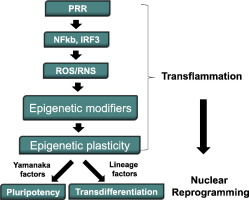Advanced Drug Delivery Reviews ( IF 15.2 ) Pub Date : 2017-09-13 , DOI: 10.1016/j.addr.2017.09.010 Shu Meng , Palas Chanda , Rajarajan A. Thandavarayan , John P. Cooke

|
Induction of pluripotency in somatic cells by retroviral overexpression of four transcription factors has revolutionized the field of stem cell biology and regenerative medicine. The efficient induction of pluripotency requires the activation of innate immune signaling in a process termed “transflammation” (Lee et al., 2012). Specifically, the stimulation of pattern recognition receptors (PRRs) causes global alterations in the expression and activity of epigenetic modifiers to favor an open chromatin configuration. Activation of toll-like receptors (TLR) or RIG-1-like receptors (RLR) (Sayed et al. 2017) trigger signaling cascades that result in NFκB or IRF-3 mediated changes in epigenetic plasticity that facilitate reprogramming. Another form of nuclear reprogramming is so-called direct reprogramming or transdifferentiation of one somatic cell to another lineage. We have shown that transdifferentiation of human fibroblasts to endothelial cells also involves transflammation (Sayed et al., 2015). Recently, we also identified reactive oxygen species (ROS) (Zhou et al. 2016) and reactive nitrogen species (RNS) (Meng et al., 2016) as mediators of innate immune signaling in nuclear reprogramming. Innate immune signaling plays a key role in nuclear reprogramming by regulating DNA accessibility (Fig. 1). Here, we review recent progress of innate immunity signaling in nuclear reprogramming and epigenetic plasticity.
中文翻译:

炎症:核重编程中的先天性免疫信号传导
逆转录病毒过表达四种转录因子诱导体细胞多能性彻底改变了干细胞生物学和再生医学领域。多能性的有效诱导需要先天性免疫信号的激活,这一过程被称为“发炎”(Lee等人,2012)。具体而言,模式识别受体(PRR)的刺激引起表观遗传修饰子的表达和活性的整体改变,从而促进了开放的染色质构型。Toll样受体(TLR)或RIG-1样受体(RLR)的激活(Sayed et al.2017)触发信号级联反应,导致NFκB或IRF-3介导的表观可塑性变化,从而有利于重新编程。核重编程的另一种形式是所谓的直接重编程或从一个体细胞到另一个谱系的转分化。我们已经表明,人类成纤维细胞向内皮细胞的转分化也涉及转炎(Sayed等人,2015)。最近,我们还确定了活性氧(ROS)(Zhou等,2016)和活性氮(RNS)(Meng等,2016)是核重编程中先天性免疫信号传导的媒介。先天性免疫信号传导通过调节DNA的可及性在核重编程中起关键作用(图1)。在这里,我们回顾了先天免疫信号在核重编程和表观遗传可塑性中的最新进展。我们还确定了活性氧(ROS)(Zhou等,2016)和活性氮(RNS)(Meng等,2016)是核重编程中先天性免疫信号传导的介体。先天性免疫信号传导通过调节DNA的可及性在核重编程中起关键作用(图1)。在这里,我们回顾了先天免疫信号在核重编程和表观遗传可塑性中的最新进展。我们还确定了活性氧(ROS)(Zhou等,2016)和活性氮(RNS)(Meng等,2016)是核重编程中先天性免疫信号传导的介体。先天性免疫信号传导通过调节DNA的可及性在核重编程中起关键作用(图1)。在这里,我们回顾了先天免疫信号在核重编程和表观遗传可塑性中的最新进展。











































 京公网安备 11010802027423号
京公网安备 11010802027423号